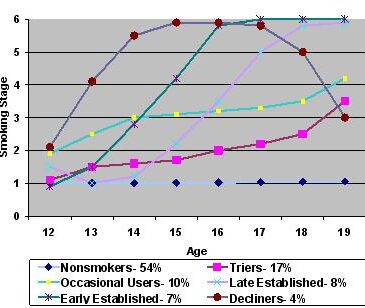Cigarette smoking patterns typically become established during adolescence (Surgeon General, 1994). This week’s ASHES reports a trajectory study about the smoking behavior of adolescents grouped by early behavior (Bernat, Erickson, Widome, Perry, & Forster, 2008).
Methods
- The researchers used a random digit dialing procedure to recruit 3,637 Minnesota youths between the ages of 12 and 16 at baseline.
- The researchers interviewed participants every six months for a three year period and used a cohort-sequential design to identify changes in smoking behavior and smoking patterns.
- Researchers created smoking stages from the participants’ reports of cigarette use.
- Using semiparametric, group based methods developed by (Nagin, 1999), researchers grouped individuals who developed similar trajectories of smoking behaviors.
- Researchers used multivariate logit models to identify the association between baseline measures and smoking trajectory; the investigators included age at baseline, community type, race, and family structure as covariates during these analyses.
Results
- The Figure shows the typical smoking stage for six distinct patterns of tobacco use across each age of the sample; these patterns are nonsmokers (54%), triers (17%), occasional users (10%), early established (7%), late established (8%), and decliners (4%).
- Researchers did not find a group who regularly smoked throughout the length of the study. One of the interesting trajectory patterns was among the decliner group, which showed an exposure adaptation trend during the length of the study. The early and late established groups continued smoking into early adulthood and became regular smokers.

Figure. Smoking stages by age for identified Adolescent smoking trajectories (adapted from Bernate et al., 2008). Click image to enlarge.
Note. Smoking stages: 1 – never smoker: never smoked; 2 – trier: smoked one whole cigarette or less; 3 – less than a monthly smoker: smoked more than one cigarette, but not in the last 30 days; 4 – experimental smoker: smoked at least once in the last 30 days; 5 – regular smoker: smoked at least once in the last week; 6 – established smoker: smoked daily/almost daily
Limitations
- The study uses self report.
- The 58.5% response rate is low; more than one third of potential adolescents opted not to participate in the study. However, researchers were able to maintain a high follow-up rate (93.1%) for this limited sample.
- The study was conducted in Minnesota and 84% of the participants were Caucasian; this sample makes it difficult to generalize these findings to other populations.
- The three year follow-up period does not allow us to project these trajectories to their completion.
Conclusion
The researchers explored smoking-related factors and how this impacted smoking trajectory throughout adolescence. The investigators identified specific adolescent smoking trajectories. These patterns illustrate that teen smokers do not always follow a pattern of increasing tobacco use. This study shows that smoking patterns change often throughout adolescent years. Based on this research, prevention specialists need to design programs for specific trajectories.
References
Bernat, D. H., Erickson, D. J., Widome, R., Perry, C. L., & Forster, J. L. (2008). Adolescent smoking trajectories: results from a population-based cohort study. Journal of Adolescent Health, 43(4), 334-340.
Nagin, D. S. (1999). Analyzing developmental trajectories: A semi-parametric, group-based approach. Psychological Methods, 4(2), 139-177.
Surgeon General. (1994). Preventing tobacco use among young people. A report of the Surgeon General. Executive summary. Morbidity and Mortality Weekly Report Recommendations and Reports, 43(RR-4), 1-10.
What do you think? Please use the comment link below to provide feedback on this article.




